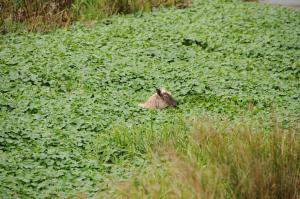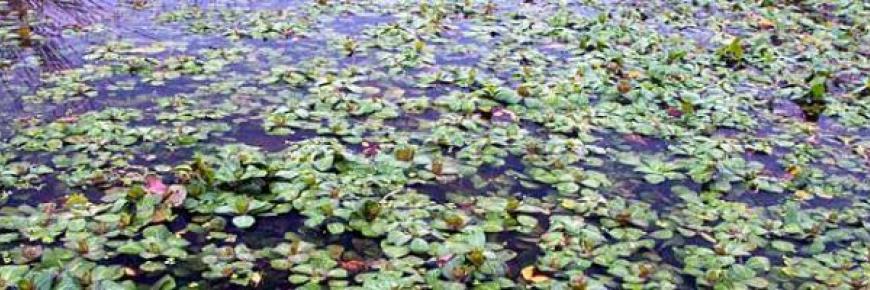Projects
Floating pennywort ©Broads Authority
Floating pennywort (Hydrocotyle ranunculoides) is native to North America. The species was brought into the UK in the aquatic nursery trade and was first found in the wild in Britain in 1990 at a site in Essex. Since then, it has spread rapidly and is proving to be particularly invasive in Norfolk. Since 2014 it has been banned from sale and it is illegal to plant or cause this species to grow in the wild.
It roots in the muddy margins of slow flowing lowland rivers and forms dense interwoven mats. In the UK, these mats have been observed to grow at up to 20cm per day! Floating pennywort reproduces principally by asexual, vegetative means and a new plant can grow from a single node; this means that extreme care must be taken when controlling an outbreak of the species. We are currently working with the Broads Authority, the Environment Agency and other partners to eradicate this species from the River Waveney.

Floating pennywort ©Trevor Renals
The rapid growth of this species can lead to the formation of dense patches, in fact these can be so dense that when the plants are emerging from water they can be mistaken for solid ground. This can easily become a problem for us, dogs and other animals which can fall in water bodies and potentially become trapped. These dense mats often outcompete native aquatic plants and clog waterways. This leads to disruption of natural river processes (erosion-deposition) and predator-prey dynamics as movement is restricted, it blocks light preventing growth of other plant species, it can lead to oxygen depletion in the water and die back increases nutrient loading. A large infestation can also facilitate increases in water temperature by absorbing sunlight which is perfect for mosquito breeding sites.
The economic costs of this species can be high. It can be a detriment to tourism for disrupting fishing and watersports, it can impact and disrupt commercial fisheries and water bodies, it can disrupt river navigation, block pipes and pumps which damages waterworks and can lead to flooding. In Britain, an estimation of the costs of chemical control for this species amounts to £250,000 to £300,000 per year.
Native to: North America
Habitat: Floating or emergent in still or slow moving freshwater
I’ve found floating pennywort on my land. What should I do?
Hand pulling floating pennywort from the Waveney ©Paul Sims
A mix of chemical and mechanical treatment is recommended due to the ability of floating pennywort to be spread by seed and vegetative growth from plant and root fragments. Careful removal is advised to reduce the number of fragments left behind. Monitoring and repeated control both throughout the season and yearly is required to completely eradicate it from the watercourse.
I want to report an infestation of floating pennywort
If you are unsure whether you have floating pennywort on your land images can be emailed to NNNSI and we can help with identification. We can also help out with management advice. If you report a sighting to us, we can update our records on the distribution of this species which will can be used to formulate future countywide management practices.
To record a sighting, take a photo, note the date and location and any other additional information such as abundance or size of area.
- Report online: NNNSI@norfolk.gov.uk

